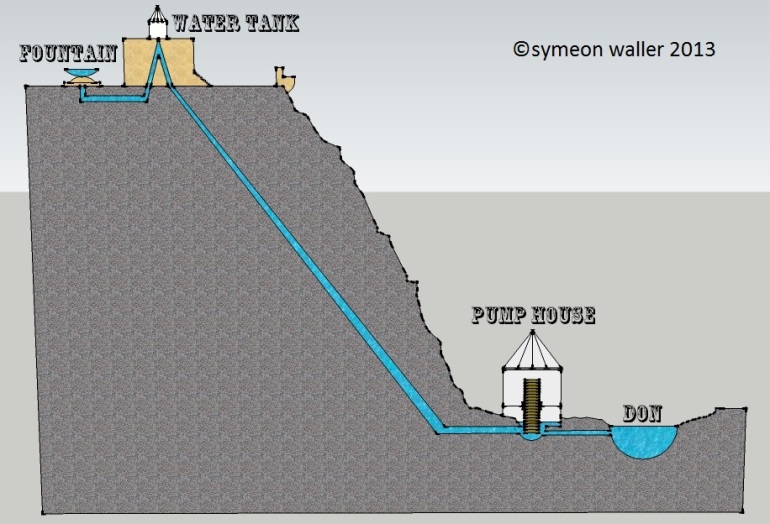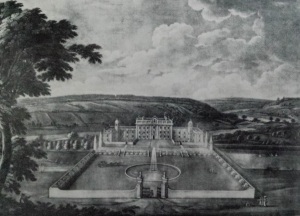On Thursday, May 18th 1967, an article appeared in the Doncaster Gazette and Chronicle newspaper which carried the headline – “CAN 17TH CENTURY PUMPING ENGINE BE PRESERVED.” The gentleman that put fingers to typewriter to write it would, although not at the time aware of it, become the next Lord of the Manor of Cusworth. Gordon Smith acted as the Estate Agent for the Battie-Wrightson family of Cusworth Park.
By 1967, the Hall at Cusworth had already left the ownership of that famous local family but ownership was retained on various properties and parcels of land within the old village of Cusworth. I say ‘the old village’ as Cusworth’s borders have now expanded on all sides resting, as they do, upon Scawsby, Scawthorpe, and Sprotbrough. Within the Parish of Sprotbrough and Cusworth were two noble families, namely the Battie-Wrightson’s and the Bewicke-Copley’s. Their relationship was up and down as they vied for position and power locally. This statement may be a little unfair though on the Battie-Wrightson family for all the stories I hear show them to be the more fair and gentlemanly of the two. Both would have been able to see the other’s mansion from their own grounds and yet no art work commissioned by either party ever displays the others house. It was the Bewicke-Copley’s that had the lion’s share of the money though, and this was apparent when one looked in more detail at the individual properties. Leaving aside Battie-Wrightson’s pile we look only at Sprotbrough in this article, in particular, the state of the art water system and pumping mechanisms.
Today in July 2013, Bernard Pearson of the Sprotbrough Preservation Society informs me that the project to preserve the ‘Pumping Engine’ (or what is left of it), continues. So, with a little mathematics I can work out that 49 years have passed with little or no progress on the saving of the structure. Sprotbrough Hall went the way of the property developers in the late 1920s after the Hall and Park had to be sold off by the family to cover colossal death duties. The ‘Pump House’ is all that remains of Sprotbrough Hall itself although there are numerous properties in Sprotbrough village that were tied to the estate. The newspaper article in 1967 highlights the plight of the pump only 40 years after the demolition of the Hall. Gordon Smith writes –
“It was mainly a desire to keep up with the Devonshire’s when Sir Godfrey Copley, of Sprotbrough Hall, set about providing his French-style garden with an ornamental fountain.
It meant that the design and construction of a pumping engine which was later recorded by the Royal Society as the first piece of water engineering of its kind and which began a fashion in country house gardens throughout Europe.
Today, this late 17th century machine, which came to fulfil the far more utilitarian purpose of providing a village water supply, rests dishonoured and largely unseen among thick foliage, now only a collection of rods, cogs, sluice-gate, pump, funnel, pipes, and waterwheel. But it may yet become a fittingly recognised memorial to Sir Godfrey’s ingenuity. Doncaster Rural Council, who had earlier scouted the possibility of moving it to the Cusworth Hall Museum, is now to make an approach to Mr. Wilf Watson, of Sprotbrough, the new owner of the land on which the engine stands to ascertain whether it can be preserved on its original site.
Sir Godfrey, who built Sprotbrough Hall in the 1660s was on a visit to Chatsworth by invitation of the William Cavendish, the 1st Duke of Devonshire, to see its magnificent gardens when he conceived the idea of having a fountain at Sprotbrough. The Duke had shown him his impressive water feature. It would be over 200 years before the 6th Duke of Devonshire would remodel the gardens at Chatsworth and install the far grander ‘Emperor Fountain’ which shot a single jet of water some 290 ft into the air. At the time of Sir Godfrey’s visit the fountain at Chatsworth would no doubt have been equally as impressive as the latter one.
Introducing a fountain to grace the grounds at Sprotbrough presented Sir Godfrey with a problem. At Chatsworth the construction of the waterworks was a relatively easy task, taking into consideration the natural formation of the land and the position of the house (a lake at the top of a hill fed pipes to the fountain in the grounds far below, giving the water some considerable pressure). At Sprotbrough the position was reversed. The Hall stood on a high ridge, and the only supply of water was the River Don, flowing nearly 100 ft below. Natural gravitation, like that at Chatsworth, was out of the question. Sir Godfrey’s determination to produce a fountain to compare with Chatsworth was not to be baulked. He designed a method of conveying water from a low position near the river, through pipes, uphill to a tank on the roof of Sprotbrough Hall. A fountain was constructed in a circular pond in the north forecourt and it was found that the water pressure in the tank produced a most successful jet.
The tank was actually in a water tower which rose above the west wing of the hall. An identical tower was built above the east wing and both were, no doubt, additions to the mansion some 20 years after it was built, purposely to house, and maybe to hide, the tank. The east tower was used to carry a clock.
A recent survey of the ruined engine house plainly indicated how Sir Godfrey’s invention operated. A channel was dug parallel to, and was fed by, the river Don, and its supply of water was controlled by sluice gates. Situated over the channel was a square, stone building, with mullioned windows, and a large waterwheel within which, when in motion, a series of rods and cogs turned. These operated a pump in a deep artesian well. Pipes from the well fed back into the wheelhouse and forced the water through lengths of underground piping uphill to the hall and also to the village.
Whenever the river flooded so did the channel and wheelhouse, with the result that the pumping engine was temporarily out of action. At these times the village could not have its automatic supply and so reverted to the use of hand pumps set over wells. This situation was remedied in the early 1900s when a gazebo-style brick engine house with a motor-pump was built nearby, to take over in an emergency.
In the 19th century, a similar pumping engine was built alongside the river Cheswold, now piped underground and running beneath the north bus station (now the interchange). The pumping house was above ground level and had an exterior waterwheel. Water was pumped through pipes to a large tank at Hall Cross Hill from where the town was supplied with water by natural gravitation. In effect, this was the same method used to work the fountain from the tank on top of Sprotbrough Hall.
Although the hall was demolished in 1926, the water pumping engine was still in use for some years afterwards to supply the village. The fountain, however, had disappeared by the early part of this (20th) century and how much earlier than that is not known. Its full glory was captured for posterity in a 17th century print which is now in the British Museum.”
I wonder if the Sprotbrough Preservation Society will finally succeed in preserving what little is left of the pump house or will it slowly fall deeper into disrepair and have to be filled in for public safety? I sincerely hope that it can be preserved for future generations. If you would like to register your interest in the latest phase of the project or if you think that you can help in any way then please contact me and I will pass your details onto Bernard Pearson of the Preservation Society.



Fascinating! Thank you! I wish we could have seen the Hall and gardens in all their glory.
Pingback: Don Valley Way project (teaser) |
Graham Jenkinson
Been for a walk from the lock towards doncaster, Have always wondered what the old pump was for, It is much clearer now all the ivy and brush wood has been cleared. Thank you for all the information on this website which explains everything I will now be able to get a nights sleep
An interesting and informative article which adds to the information often quoted about this early pumping engine. Pity it does not refer to the fact that it was initially designed and installed by Derby Engineer George Sorocold.
BOTH MY HUSBAND AND MYSELF ENJOYED THIS ACCOUNT OF THE PUMP HOUSE AND ITS CONSTRUCTION.
VERY MUCH APPRECIATED. THANK YOU FOR THE TIME SPENT PRESENTING THIS EXCELLENT ARTICLE.